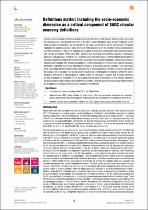| dc.contributor.author | Grobler, Lizette | |
| dc.contributor.author | Schenck, Catherina | |
| dc.contributor.author | Blaauw, Derick | |
| dc.date.accessioned | 2022-09-19T12:57:18Z | |
| dc.date.available | 2022-09-19T12:57:18Z | |
| dc.date.issued | 2022 | |
| dc.identifier.citation | Grobler, L. et al. (2022). Definitions matter: Including the socio-economic dimension as a critical component of SADC circular economy definitions. South African Journal of Science, 118, #12550. . https://doi. org/10.17159/sajs.2022/12550 | en_US |
| dc.identifier.issn | 1996-7489 | |
| dc.identifier.uri | https://doi. org/10.17159/sajs.2022/12550 | |
| dc.identifier.uri | http://hdl.handle.net/10566/7918 | |
| dc.description.abstract | Globally, scholars agree that there is a lack of clarity on the notion of the circular economy (CE) and a lack
of consensus on a foundational definition of the term. Some definitions place greater emphasis on the
socio-economic dimension of the CE than others. In Africa, notions of the CE are still evolving. This paper
highlights the salient aspects of texts defining or informing the CE in the Southern African Development
Community (SADC). In Africa, the transition to circularity is motivated by the need to stimulate job creation
and income generation. At the same time, concern over mounting environmental impacts is increasing.
Economic and population growth on the continent, continued urbanisation, and the resulting proliferation of
municipal waste contribute to these economic, social and environmental challenges. | en_US |
| dc.language.iso | en | en_US |
| dc.publisher | Academy of Science of South Africa | en_US |
| dc.subject | Circular economy | en_US |
| dc.subject | Socio-economic dimensions | en_US |
| dc.subject | Grey literature | en_US |
| dc.subject | Africa | en_US |
| dc.title | Definitions matter: Including the socio-economic dimension as a critical component of SADC circular economy definitions | en_US |
| dc.type | Article | en_US |

